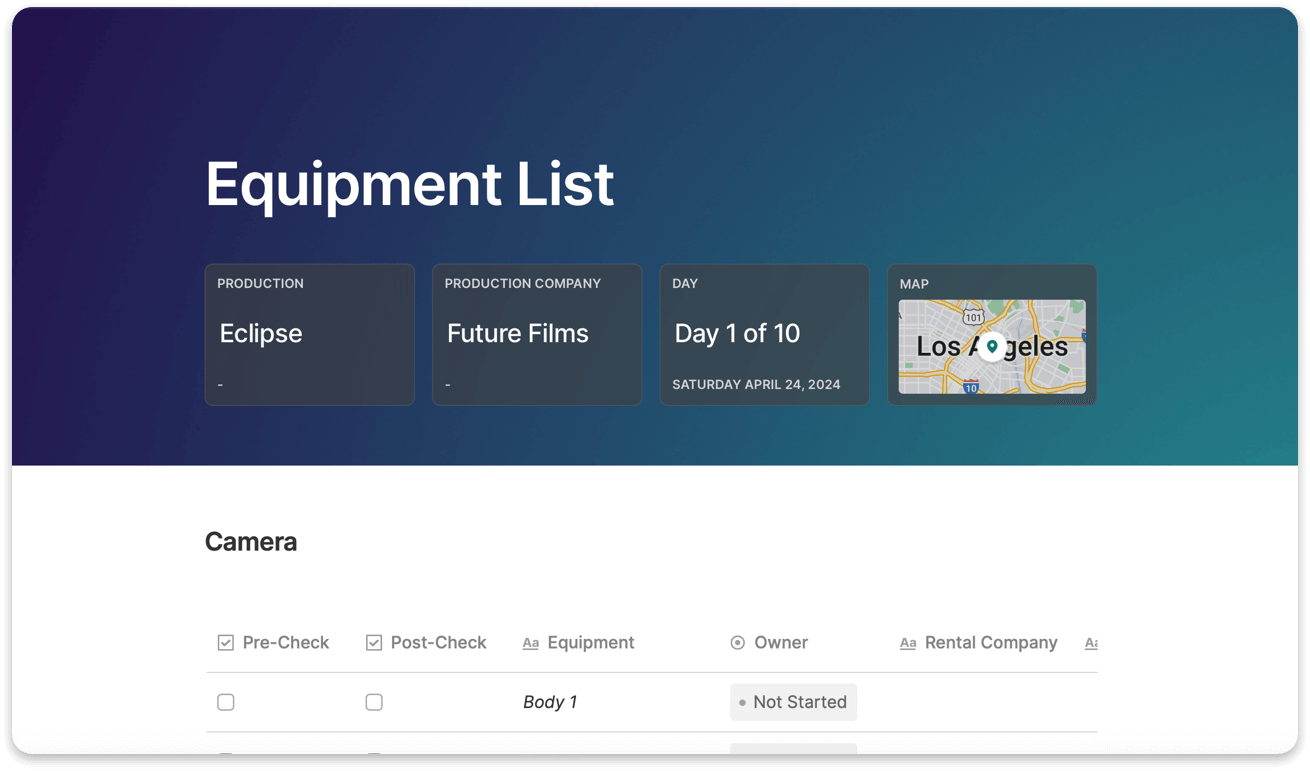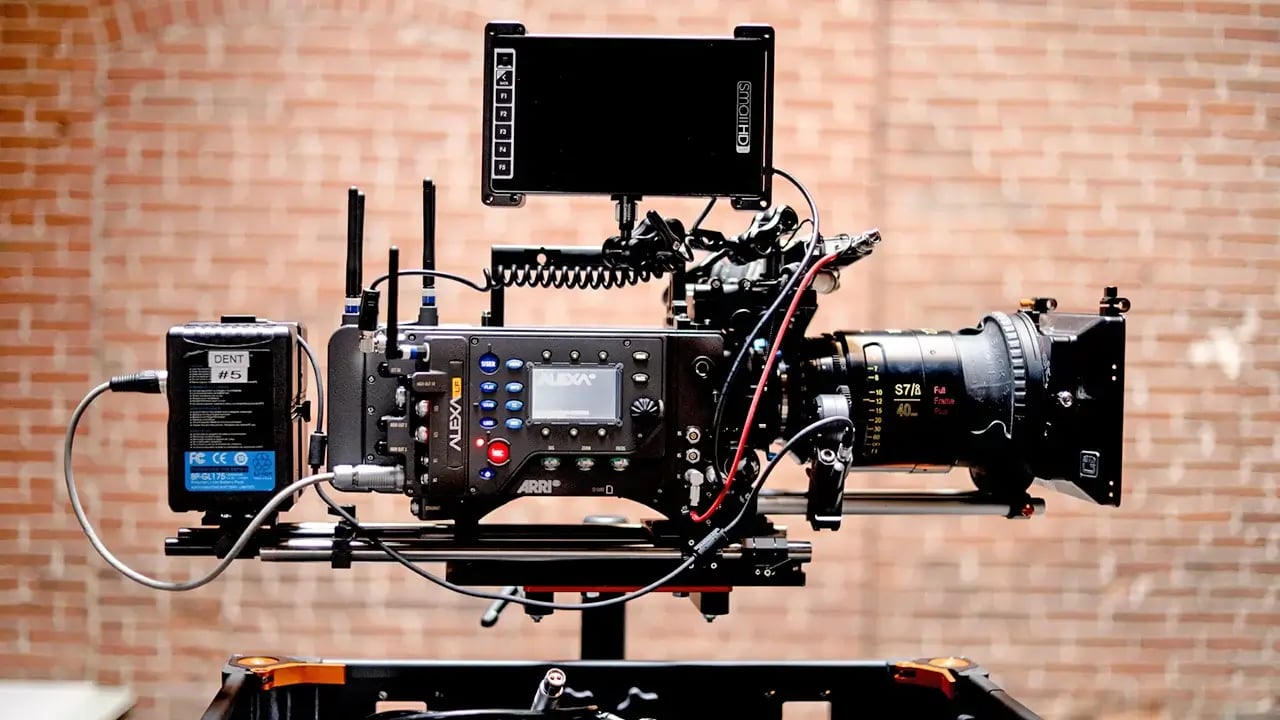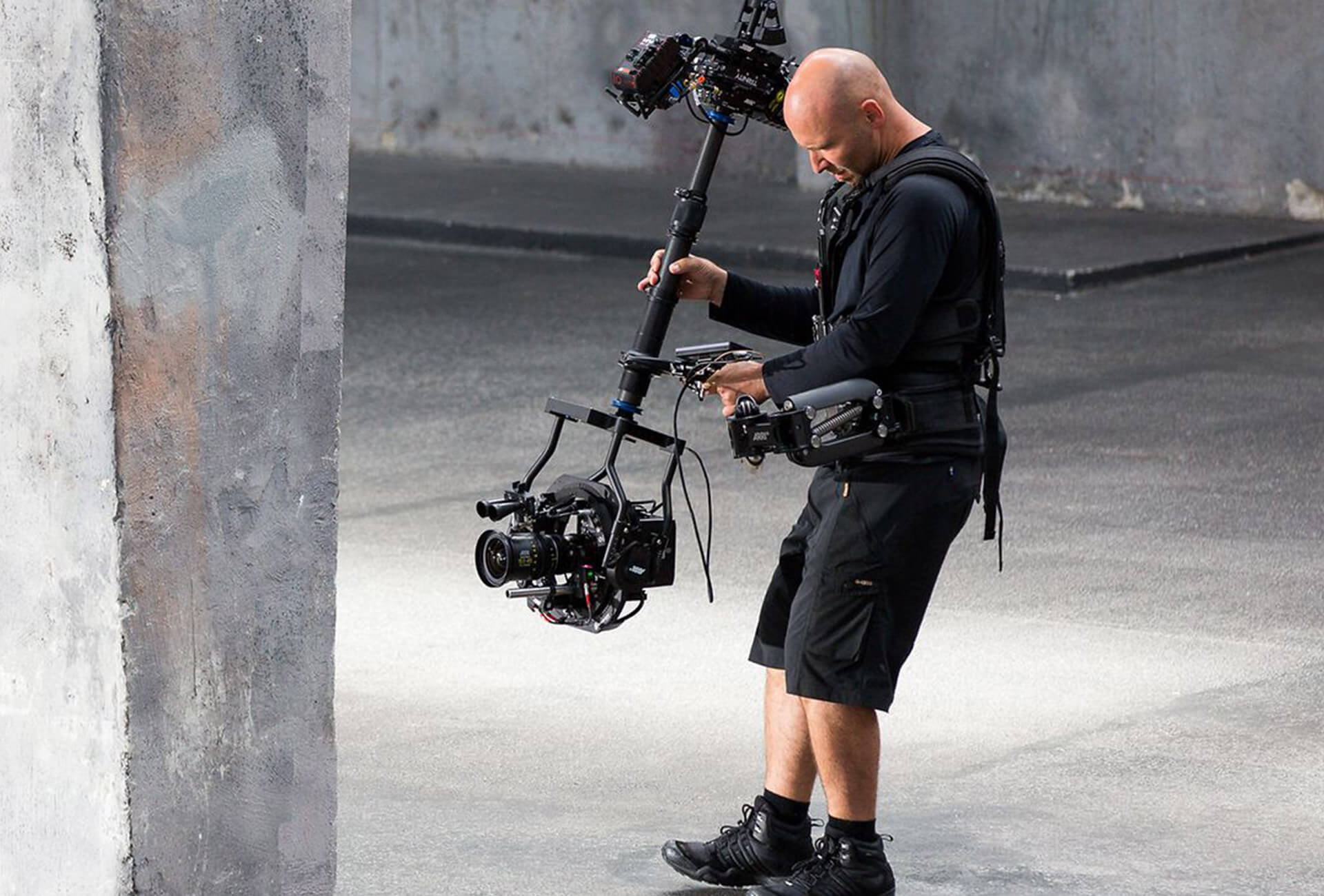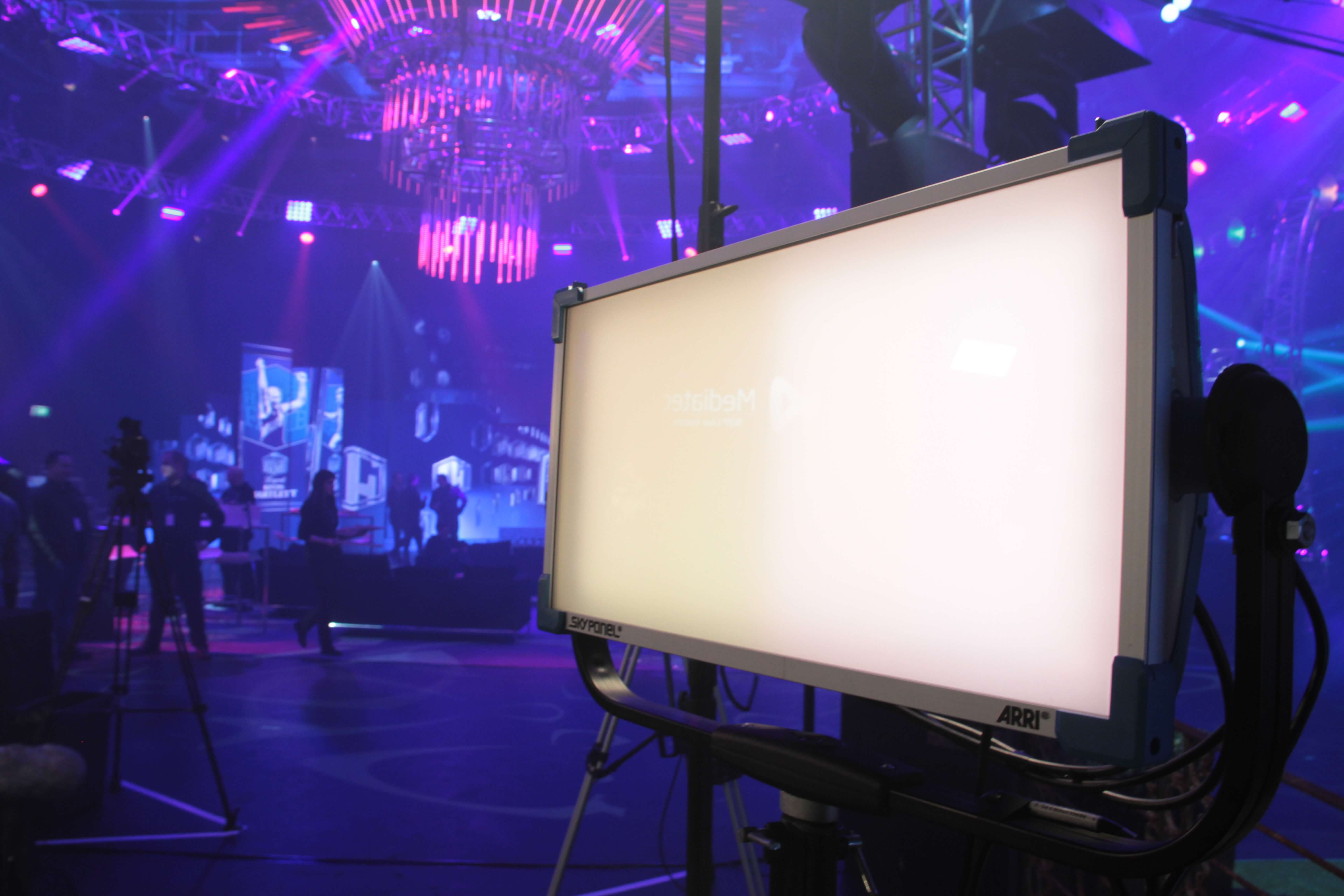Like any profession, filmmakers use various tools and equipment to bring their vision to life. Most filmmaking gear is used during production to help capture the visual and audio elements needed to tell the story. This article will examine the essential filmmaking gear you need to produce a film or video, categorized by department.
You can also access Assemble's cloud-based film equipment list template below to keep track of your gear on your next shoot. This fully customizable template includes columns to track your gear, return dates, and more.

Film Equipment List Template
Use our film equipment list template to track the gear used on your productions.
Get TemplateWhat Equipment Do You Need To Film A Video?
Filming a video requires a combination of different equipment to create a professional production. Generally speaking, you'll want to select a high quality camera, lenses, camera support, a set of lights, an audio recording device, and sufficient memory cards to capture the video and audio files.
Below, we'll break down the essentials in detail, based on each department of the film crew.
Camera Department
Camera Body
The camera records the video footage and is the most essential piece of equipment on a film set. Based on the budget and scope of the project, a variety of options are available to you. Large-scale Hollywood productions use a cinema camera such as the ARRI Alexa. Meanwhile, low-budget productions often use a mirrorless camera (such as the Sony A7S) or a DSLR video camera. Cameras are battery-powered, but a single battery will not last for a full 12-hour shoot day. So be sure to carry at least one extra battery and charger kit.

Lenses
A camera lens must be attached to the body to capture the footage. Lenses come in different shapes and sizes, with each type of lens creating a unique look. Usually, cinematographers choose between zoom or prime lenses. A zoom lens allows you to manually zoom between different focal lengths, whereas a prime lens has a fixed focal length. For smaller-budget shoots, you should be able to fit all the lenses, camera body, and any camera accessories into a camera bag.
Follow Focus
A follow focus is a piece of equipment attached to the camera lens, allowing the cinematographer or 1st AC to adjust the focus ring on the lens. As actors or objects move across the frame, they might move out of focus, becoming blurry. The focus puller must calibrate and operate the follow focus to ensure that the subject remains sharp and in clear focus. The follow focus allows them to adjust the focus without touching the camera during the take.
Memory Cards
Digital cameras save recorded footage onto memory cards. Once the memory card is full or the shoot is complete, you can eject it from the camera and transfer the footage onto an external hard drive via a computer. You cannot shoot any footage without a memory card, so it is vital. Make sure you bring multiple memory cards as backups to avoid any potential delays.
Tripod
The tripod is a three-legged stand that holds the camera. Tripods are comprised of two key parts: the sticks, which are the legs of the tripod, and the tripod head, an adaptor that attaches the camera to the sticks. You can choose from different tripod heads, such as a ball head, fluid head, gimbal, and more, based on the cinematic effect you wish to achieve.
Monitors
Most cameras have a small built-in display, but connecting to an external monitor allows the cinematographer to view the frame on a bigger screen. It also enables the director, producers, and other crew to watch the take as it is filmed. Cinematographers usually use an on-camera monitor, whereas directors and other crew will view the camera feed from a larger on-set monitor.
Steadicam or Gimbal
Steadicams and gimbals are specialized pieces of equipment that enable you to move the camera through space while eliminating shaking or jerking of the camera. The Steadicam is an older and manual solution that uses physics (specifically inertia) to balance the camera's weight through the camera operator's body. This eliminates any shaking, creating a smooth camera movement. On the other hand, the gimbal is a modern and electronic solution. The gimbal uses motors to detect the camera movement and automatically calibrates its position, ensuring the camera remains stable while the operator moves.
 Jib
Jib
Jibs are specialized filmmaking gear that allows you to achieve cinematic overhead shots. It is a type of crane that can push the camera vertically to capture a unique perspective of the location. The jib contains counterweights, and the camera is attached to the other end, allowing the cinematographer to push the camera up smoothly while pulling the weight down. Manually operated jibs are portable and affordable. However, if your budget allows, you could opt for a larger, remote-controlled electronic jib or even a crane.
Grip & Electric Department
Lighting Units
Most film shoots will use artificial lighting to emphasize the film's visual look. Cinematographers and their gaffers often require a lighting kit comprising many individual units. Lighting equipment can range from expensive HMI lights that can mimic daylight to cost-effective LED panels. Other options include tungsten or fluorescent lights. LED panels are a good starting option for indie filmmakers as they are moderately priced, compact, and portable.
 Stands
Stands
Stands are used to hold the lighting units when setting up for shots. They can also hold flags, mirrors, bounces, reflectors, or any other G&E (grip and electric) equipment. Usually, a grip package will include a variety of stands, such as C-stands, combo stands, or high roller stands. Stands are generally selected based on the weight of the equipment they will hold.
Stingers
Stingers are heavy-duty extension cords that run electricity from the power source to the lighting units on set. Unlike standard extension cords, stingers are made out of high quality materials because they need to handle the lighting unit's higher amperage.
Sandbags
Sandbags are a vital piece of equipment required for safety on set. Sandbags are attached to the bottom of a stand to lower its center of gravity. Some lighting units are heavy, and when connected to a tall stand, they could tip over and fall due to the imbalance of weight. Sandbags prevent this and ensure that the crew and equipment remain safe.
Reflectors
Cinematographers use reflectors to bounce artificial or natural light in a particular direction. While lighting units can create a scene's overall visual look, reflectors can subtly accentuate an actor or object. They can be found in various shapes, sizes, and colors, with each type creating a unique visual effect.
Flags
Unlike reflectors, flags block artificial or natural light seen in the camera's frame. Also referred to as solids, flags are rectangular, opaque, and black. A G&E package usually consists of a few solids varying in size and shape.
Generator
Sometimes, your film set might not have an inbuilt power source to draw electricity from (especially in exterior locations). In these situations, a portable generator can power all the lights and any other electrical appliances on set.
Lighting Gels
Lighting gels are thin plastic sheets that can be attached to a lighting unit to change the color or diffusion of the light. They are essentially filters and are available in different colors and opacity levels. Certain lighting units, such as LED panels, have built-in controls that allows you to adjust the color, temperature, brightness, and more without the need for gels.
Dolly
A camera dolly is a platform or cart that can move the cinematographer and camera along a set of tracks. A dolly is used for cinematic shots that require controlled, smooth camera movement. Usually, a separate crew member, known as the dolly grip, is responsible for laying down the tracks and moving the dolly during a take. Sliders are a more affordable and portable option to the dolly. A slider is a compact, miniature dolly that can be attached to stands or tripods to create smooth camera movement.
Sound Department
Field Audio Recorder
The field audio recorder is a portable device that saves audio recorded by microphones. The sound mixer traditionally operates the recorder and oversees the sound levels, listening to ensure the sound is balanced. The field audio recorder can connect to microphones via Bluetooth or XLR cables (more on that below).
Shotgun Microphone
The shotgun microphone is the device that captures the audio. It is attached to the top of a boom pole but can also be connected directly to the camera. This gives you the flexibility to record audio directly to the camera without having to sync separate audio files during post-production.
Boom Pole
The boom pole is a long, extendable device that holds the microphone. The boom pole operator holds the boom pole and microphone, which will transmit audio to the field audio recorder. Traditional boom poles can extend to over 12 feet.
 XLR Cables
XLR Cables
XLR cables are a particular type of cable that connects the microphone to the audio recorder. Bluetooth technology on audio filmmaking gear can be unreliable, so it is best practice to carry XLR cables as a backup.
LAV Mics
Lavalier microphones, nicknamed LAV mics, are miniature microphones that can be attached to an actor's person. A wire connects the microphone to a pocket-sized transmitter, which uses Bluetooth technology to transmit audio to the receiver.
Post-Production Department
Computer
Modern post-production is an entirely digital process, so a desktop computer or laptop with sufficient hard disk space is required. You will also want to have a computer on set to backup footage and review the files.
Storage Devices
Storage devices, such as an external hard drive or solid-state drive (SSD), facilitate the transfer of footage from production to post-production. Before handing off the footage to the post-production crew, ensure you make a copy as a backup for safety. Similarly, if you use cloud-based storage solutions, keep a copy of the footage in physical form via an external hard drive.
Post Production Software
The post-production crew will need specialized filmmaking software to compile the footage and create the final video. Editors often use editing software such as Adobe Premiere Pro or Final Cut Pro to create the visual backbone of the video. Sound designers use software like Adobe Audition, Ableton Live, or Pro Tools to design and mix the soundtrack. Finally, for CGI or VFX workflow, you can use Adobe After Effects, Maya, Blender, Cinema 4D, and more.

This article provides an overview of essential filmmaking gear. However, filmmaking tools are always evolving. Exciting new technologies such as virtual production, FPV drones and more keep filmmakers on the cutting edge of what's possible. With all of these new tools, your imagination is no longer limited by physical constraints.

